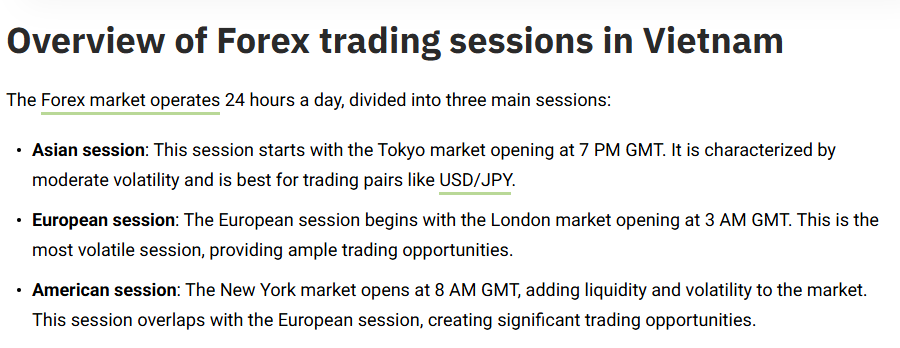Forex Time Zones: Best Trading Hours for Asian Traders — A Practical Q&A
For many traders in Asia, the 24-hour nature of the forex market feels both empowering and exhausting. Markets move while we sleep, and volatility often arrives at inconvenient hours. Yet, with the right understanding of forex time zones, it’s possible to build a trading rhythm that aligns with both market energy and personal wellbeing — particularly for those trading out of Vietnam.
We’ve rounded up seven frequently asked questions to unpack when and why specific time windows matter, what the best trading hours really look like, and how Vietnamese traders can make time work in their favor.
1. What are the main forex market sessions, and how do they map to Vietnam time?
The global forex market operates across four primary trading sessions: Sydney, Tokyo, London, and New York. These are not rigid blocks, but overlapping periods where activity surges or softens. When translated into Vietnam’s time zone, the Sydney session kicks off around 5 AM, Tokyo follows from about 6 AM, London opens at 2 PM, and New York begins its run at 8 PM. The key takeaway? If you’re in Vietnam, your most active windows don’t necessarily fall within standard work hours — but they can still be managed with planning.
2. When is the most active and optimal trading time for Vietnamese traders?

Credit from Forexearlywarning
Liquidity — the lifeblood of any forex strategy — tends to concentrate during overlapping sessions. For those in Vietnam, the most favorable overlap happens in the late afternoon and evening. The Tokyo–London crossover, typically from 1 to 4 PM Vietnam time, offers decent movement. But it’s the London–New York overlap, around 7 to 10 PM, that tends to bring stronger momentum. Many traders build routines around this period, often seeing it as the optimal forex trading time in Vietnam.
3. Is it realistic to trade during the Vietnam morning hours?

Credit from Traders Union
While it may not be peak volatility time, the early morning can still offer solid opportunities — especially during the tail end of the Tokyo session. Pairs like USD/JPY or AUD/JPY see decent activity, and price action tends to be more technical and range-bound. For traders who prefer a quieter environment or need to be finished before the afternoon, this window is certainly usable — though they may need to adjust expectations on speed and scale.
4. What defines the Vietnam forex session, and is it worth participating in?
Technically speaking, Vietnam doesn’t have its own distinct forex session — it sits within the broader Asia-Pacific window, anchored by Tokyo. Still, local traders often refer to the early hours (6 to 10 AM) as their “Vietnam forex session.” It’s a time for preparation, trend spotting, and placing low-volatility trades. It may not suit every strategy, but for some, it’s an ideal way to ease into the day before heavier action begins.
5. Do different forex time zones reflect different trading behaviors?

Credit from FXOpen UK
Absolutely. The Tokyo session tends to be quieter and more technical, driven by cautious institutional moves. London is where the tempo increases — fueled by major economic releases, European momentum, and the sheer volume of participants. Then comes New York, often volatile and news-reactive, especially during early hours. Recognizing these behavioral shifts can help traders adapt — not just in terms of timing, but in mindset and risk management.
6. What about low-volatility periods — should they be avoided completely?
Not necessarily. While thin markets can be frustrating, they also offer opportunities for range trading, tight stop-loss strategies, and planning entries for the next session. Between 10 AM and 1 PM Vietnam time, for example, price movements may be slower, but the calm can work to a trader’s advantage. Some strategies rely on this consistency to build toward bigger trades later in the day.
7. Can forex trading become a sustainable routine for those in Vietnam?

Credit from HVA Group
It can — and often does. Many Vietnamese traders develop personal trading routines built around their life schedules. Some prefer to rise early, catch the Tokyo action, and finish before lunch. Others find balance by trading the evening London-New York overlap after work. What’s most important is aligning strategy with your natural rhythm — because even in a market that runs 24/5, no one can (or should) be present all the time.
Final Thought: Let Time Work for You
In the end, knowing the best trading hours isn’t just a technical detail — it’s a cornerstone of emotional discipline and practical trading health. Whether you’re scanning the forex time zones from Hanoi, Ho Chi Minh City, or anywhere across Asia, the ability to map global flows onto your local reality is a skill worth honing. After all, in forex, timing isn’t everything — but it certainly helps.




